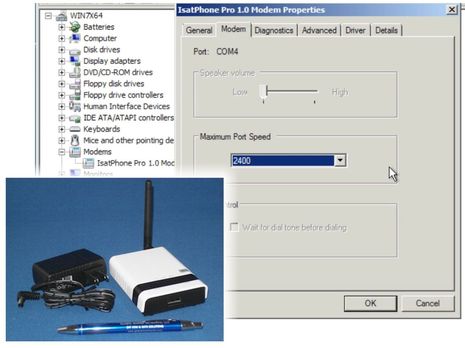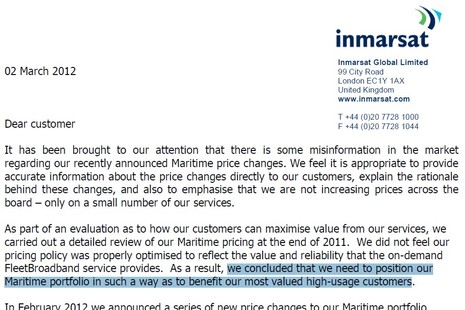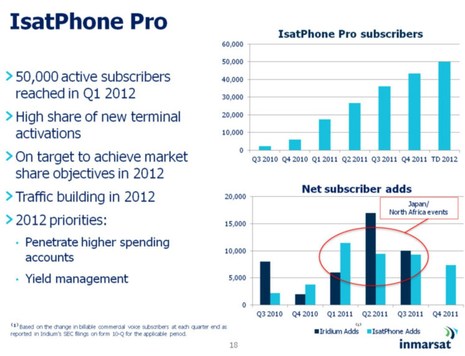GMN’s wXa-102 satellite router, but Inmarsat rate increases too?
I hear that trying to use the Inmarsat iSatphone Pro’s low-speed but high-latency data connection can be extremely frustrating, as we partially anticipated when it became possible last winter. Meanwhile, the folks who’ve invested in broadband satellite connections tend to worry a lot about extraneous programs that eat expensive megabytes. And regardless of their satcom speeds most everyone these days wants the freedom to use it with any of their computing devices. Well, it looks like Global Marine Network’s new RedPort wXa-102 WiFi router/firewall may be an elegant solution to all these issues…
The little USB router can apparently connect to numerous Inmarsat, Iridium, Globalstar, etc satcom devices without your having to load drivers or tweak setups on your computers, and it also firewalls off everything except GMN programs like XGate and XWeb (and relatives like OCENS Mail and GMPCS Speedmail). Hence you can connect whatever device you want over WiFi and get maximum use of the narrowest band or most cost efficient use of broadband. Plus the wXa-102 can run on 12 volts or an optional battery pack, and it seems reasonable at $150. Nice!
Unfortunately I must also report that I’ve just seen a leaked email strongly suggesting that Inmarsat is going to significantly raise its rates in the months ahead. You may recall that Inmarsat caused a stir last year when it enacted rate policy changes that seemed particularly hurtful to cruisers who used Fleet Broadband lightly or only for parts of the year. That situation was tough to figure out as there are so many layers between Inmarsat and the end customer, and some of those layers (like KVH) also compete against Inmarsat with their VSAT service (which can now be globalized with integrated Iridium OpenPort). I was also pleased to learn last fall that Intellian is somehow offering lower-end FB service bundles that can be turned on and off without fees.
But if I understand the email correctly that minimum $55 plan listed below may more than triple in May, and it will have nothing to do with Intellian. In fact, it looks like almost all Inmarsat rates, including Sat C and Mini-M, will go up to some degree regardless of the distribution partner or service provider involved. I’ll certainly be interested in the reaction when and if these leaked rate changes materialize, and I’m quite willing to report on Inmarsat’s side of the story — could the failing LightSquared deal have something to do with this? — but it surely looks like the company doesn’t feel much obligation to the boaters who purchased expensive yacht-size FB hardware once able to get online most anywhere at reasonable costs if carefully used.
PS 3/2: I don’t know if this Panbo entry had anything to do with today’s Inmarsat letter attempting to explain the coming rate changes, but unfortunately I see no reassurance for customers who use their satellite services lightly or seasonally. For instance, how the heck does raising minimum monthly rates “benefit” Inmarsat’s “most valued high-usage customers”? Does Inmarsat not understand how locked-in their low-usage customers are, or are they banking on it? The lowest priced Fleet Broadband terminal is $5000, I think, and that’s before installation. And when the FB 150 debuted in 2009, it was Inmarsat itself crowing about how “affordable” it was for cruising yachts. If I’d bought one then I’d be outraged if the minimum rates available when I made the purchase went up drastically.
Heck, even cell service companies are careful about this sort of behaviour, which is why I still have a $30 unlimited data plan even though Verizon went to metered plans last year. Satellite Phone Support is reporting that Inmarsat will also raise hardware prices and service rates on the iSatphone Pro and goes on to suggest that it might be a good idea to get one now. I’ve been enthusiastic about that phone myself, but I question buying any communications hardware when the sole service provider seems to think it’s perfectly OK to raise rates when they “feel this change properly reflects the value.” You can download the Inmarsat letter here; what do you think?
















My new Galaxy Nexus phone is very good at tracking data use, which is useful because some apps have huge appetites for it! For instance, between 2/5 and today WeatherBug Elite has downloaded 124 mb, 121 of which was done in the background!
Using a WeatherBug NEXRAD map as the phone’s wallpaper was a bad idea in terms of battery life, but it didn’t cost me anything else because I have an unlimited data plan. However, if I’d been doing something like that over a basic Fleet Broadband plan, I would have been billed over $1,700! It’s important to have solid firewall protection — like this GMN wXa router — over an expensive metered internet connection is what I’m trying to say.
One nice feature of the wxa-102 not mentioned above is that it allows Apple iOS users (iPod touch, iPad, and iPhones) to do email and browsing over their satellite phones.
for example user equipped with iPads, iNavX, wxa-102, satellite phone, and XGate have everything they need for their electronic charting, weather, and communications.
Take care.
–luis
One more thing…
with the use of USB to serial adapter cable the wxa-102 can be used with serial port based phones such as the iridium 9505a. So… users with older phones can now use them with their iOS devices.
Take care.
–luis
Luis did some amazing stuff this winter. I was involved a fair bit with testing the AxcessPoint hardware and software and integrating iOS with his Swiss Army knife of sat comms software XGate. It is truly amazing to be able to sit at an iPad (or iPhone, or laptop or etc., etc., etc) and bounce stuff up and down over a sat link.
I just got a wxa-102 a couple of days ago to test with. It is presently connected to my trusty OLD 9505a via a USB to serial adaptor and is completely transparent. The wxa-102 comes with some very powerful admin SW and the 12v power makes it an ideal solution on the boat.
As more hard/software comes online, the options available to voyagers start to get interesting and dealing with rates and their inevitable increases gets a little less painful.
Trouble signing in to Panbo? We had to do a security update to the blog software (MT) and you may have to “empty the cache” of your browser in order to sign to comments or the Forum. Another way to overcome the problem is to find and delete instances of “mt.js” and “mt-site.js”. Sorry for the inconvenience.
Note too that I added a significant PS to this entry about the Inmarsat rate changes.
Will there be knock on costs for tracking devices using Immarsat?
I think they’ve just knocked the bottom out of hardware sales. I can’t see many cruisers adding Fleet Broadband to their outfitting budget when the costs of actually using the gear have gone up so much. Perhaps we’ll see more cruisers relying on SSB with a Pactor modem. That’s what I’ll be using, with the addition of a sat phone for emergencies.
Inmarsat price hikes would not surprise me.
It’s possible that Inmarsat simply misjudged the market for their services, and ended up selling more hardware than the satellites could support (but not enough to justify launching another bird)- in which case price hikes would help free up the bandwidth for the most lucrative customers.
Or they may have planned this from the start, setting teaser rates for a few years to undercut Iridium, while knowing that they could crank prices back up once everyone was locked in.
Either way, we should not pretend that satellite communications is a competitive market. There aren’t many choices, and it’s financially prohibitive to switch after you’ve made your choice.
Thanks, Matt, but I’m a wee bit dubious about your analysis. The leaked email indicates that the only rates lowered are for plans starting at 500MB per month (though they’re only 1-2% wholesale). Inmarsat charged much more per Meg for smaller plans even before steep rate increases, so it’s hard to see them as load balancing.
Maybe there’s another explanation but it’s hard not to see a huge increase in minimal monthly rates as a callous squeeze play. Some users will suck it up and buy more service than they want to, others will bail. What gets me is that Inmarsat seemed to encourage low volume and irregular use just a few years ago. The FB150 versus Iridium OpenPort magazine articles and Panbo entries ( http://goo.gl/oR713 ) that Gram Schweikert wrote in 2010 would not have happened without support from Inmarsat.
We have not yet actually seen a much higher minimum rate enacted, but if we do then Gram’s premise about reasonably economical cruising communications with Fleet Broadband, and especially his cost comparisons ( http://goo.gl/oR713 ), will be history. And a lot of FB150 terminals may show up on eBay and/or Panbo Classifieds! And, again, just how does cutting off low volume users benefit the high volume ones?
There is competition, though. Iridium is just updating the OpenPort hardware to OpenPort Pilot for better performance. Plus their AxcessPoint router and the GMN wXa discussed above promise to wring the most from narrowband satphone data, and make it easy. Meanwhile, Globalstar keeps getting better and may have an economical broadband service eventually.
Inmarsat also has serious competition on the high end. When the service costs are staggering, ships and megayachts aren’t locked in to even very expensive hardware set ups. Lots have already added VSAT, for instance, and I just learned recently that KVH is upping its high-end game with a V11 Mini-VSAT terminal that has worldwide C band coverage built in:
http://progressive.kvh.com/v11/
This would seem like a good time for Inmarsat to treat all its existing customers well.
I just spoke with outfitter satellite phones as I was considering the ISatPhone.
They tell me they expect a monthly rate increase for the phone, going from $15.00/moth for the basic access; to $20.00 or maybe more. They thought $30.00/month was possible!!! With that in mind I will wait until the end of the month to see what INMARSAT decides. In the meantime I will look at Iridium.
Does anyone have actual working experience with the using the IsatPhone Pro on the high seas for email (downloading GRIBs, etc)? I’ve seen some reviews but they seem to have been done by people who are unfamiliar with the realities of satphones in general.
I’m very familiar with using the Iridium phones, XGate, and OCENS, but would like to hear a reliable first or second-hand report on the IsatPhone Pro. I’m in a position where I am asked for advice on satphones, and would like some accurate information.
We never thought the iSatPhone Pro monthly rates made any sense, so we went the prepaid/”top-up” route when we crossed the Pacific last year. The prepaid cards only work outside U.S. waters, but that was fine for us. Buying in 500 minute blocks, the prcie was about $0.70/minute,
Will the price of newly purchased prepaid units go up as well, or worse yet will Inmarsat start charging more units per minute of voice time or per text message, making existing prepaid cards worth less than expected at the time they were purchased? That would be…sinister.
/afb
Adam, did you try email with the phone? I am very interested in the performance: making the connection, keeping the connection, and actual throughput.
Did you use the built-in antenna, or an external one?
Thanks,
Paul
Adam, the leaked email I saw didn’t say much about iSatPhone Pro rates, or not that I could decipher, but TMF Associates seems to think they’re about to go up substantially:
http://tmfassociates.com/blog/2012/02/23/going-up/
Then again they later referenced this entry about how FB rates were going up, but left out all my qualifiers:
http://tmfassociates.com/blog/2012/03/03/explode-or-implode/
KVH just selected as “preferred satellite communications solution” by the world’s largest ship management company, apparently beating out Inmarsat: http://goo.gl/N4n3W
In covering that event a Raymond James analyst referenced this entry. Funny world!
I have a Beam Oceana on loan for a review. It’s basically an Isatphone set up as a fixed install. Via Onsatmail (UUPlus), it took right at 2 minutes to download a 22K grib file. About 1/2 of that is establishing the connection, so I’m not sure how much is billed yet.
I also have a regular Isatphone Pro and a Globalstar GSP1600 on board. As part of the review, I’m going to compare the download times between the 3 phones. But I just got around to setting up the data connections on all of them. Give me a couple of weeks and I will have some data to report.
I think you can expect similar results to my test above on the portable Isatphone.
I went prepaid on my Isatphone Pro. When I left the US last April, I found that generally by the time I lost cell phone coverage, the Isatphone worked. YMMV, but unless you are a heavy user, or need land coverage in the US, prepaid is a better option. I’m hoping they don’t change those rates much.
We got the Globalstar for chatting back home. At the time, and so far we have been left grandfathered in, the cost is a flat 25 bucks a month for all you care to use the phone for voice or data. Globalstar does still have coverage issues, but with their recent launches, the call windows have been improving. They have a website where you provide your position and it tells you when service will be available. It works. I think the current plan is about 40-45 a month. I think it’s only good in North and South America for the all you can use rate plan. Calls to the US are “free”, but there are toll charges to call anywhere else. You get a US number and incoming calls are “free”. This is not yet a good emergency phone….but for weather and routine calls home we like it.
Both portables work well with the built in antenna, but you have to be outside and in the open. They won’t work under our fiberglass hardtop over the sun deck, but do work somewhat under a bimini top on the fly bridge. The Oceana has an active antenna and based on bars seems a bit better than the portable. One thing to consider is a Isatphone plus a Beam dock and you might get the best of both worlds. But if you need more than grib files and text email from the internet, you will be disappointed in the data feature. Web surfing won’t work.
Paul, we never used data on the iSatPhone Pro. For data I bought a used Hughes 9201 BGAN unit. We got a $120/mo. plan with 20MB included; excess data was about $7/MB. Though BGAN isn’t for marine use and we may have been operating outside the ToS, it worked extremely well for us. Connect time was quick, downloads were fast (~500kbps), and we could generally do a lot of email/weather with 20MB.
The iSatPhone worked well for us, though as Bob says it won’t work inside the pilot house. We bought a Beam dock which worked fairly well though had some firmware issues that were a bit of a nuisance.
If I were doing it all again I’d consider the KVH V3 but the big upfront costs (hardware and install) equal a lot of MB on the BGAN…
Adam, Did you use the BGAN while underway?
Also I’ve expanded on Inmarsat rate change info here:
https://panbo.com/archives/2012/03/inmarsat_boxed_in_by_attacks_from_all_sides.html
Have been testing GMN’s wXa-102 in the UK, with an isatphone pro. The unit is superb, eliminating the hassle that can come with drivers and MS-Windows. I have a MSWin, Mac and iDevice environment, so the unit is very handy.
I have been testing mostly with the iPad and iPhone 4, using Weather4D Pro (gribs via saildocs) and email all via xgate.
So far, very pleased with the results. The Isatphone Pro is not for heavy data use, but the wXa-102 certainly makes it plug-n-play, enabling the use of the Isatphone for occasional or minimal data a piece of cake.
It looks like the MailASail RebBox tries to do what the GMN WiFi box does plus multiplex NMEA data to onboard mobiles, and more:
http://www.mailasail.com/Communication/Red-Box
I use a wxa-102 with an isat phone and an Iridium 9555, and it performs extremely well for me
I purchased one of the Skipper 150 units on the low end FB150 plan. Prior to that I had a TracPhone252 and my 1st installation was a SeaTel on Globalstar. To be honest both INMARSAT Mini M and Fleet Broadband services blew away the Globalstar service. I rarely used the phone or internet but during the hurricane last summer that just touhed us in southern New Jersey I was able to go to the boat and make important calls and business e-mails while my Son’s waited 4-5 days back home and at the office for power, local cellular towers, the telephone lines and Comcast Cable/Internet to be repaired. I recently dropped the Fleet service not because of the hardware because I couldn’t justify the monthly costs when I wasn’t using the terminal. So the Skipper 150 currently sits on the boat with a deactivated SIM card.
You would think in this economy the sat service providers would be happy to collect $20 to $30 a month for someone who paid full price for the equipment and doesn’t tie up their network? I am not about to purchase the VSAT phone to have them change the rates again. I just can not justify the equipment cost or the Fleet Broadband service currently installed considering it was only for emergency use. We just got Verizon LTE in our primary boating area and have had AT&T HSPA+ (using an Ericsson W35) for a few years. In addition I use a high power Wave EC unit on WiFi. I’d rather spend the money on extra Verizon LTE data then on the Skipper 150 Sat terminal that did 150kbps on data. I actually wish I would have kept the KVH 252
Bill
MV; Wireless One
Hello All,
Just an update on the wxa-102 which has been renamed the Satellite Optimizer.
1. it now supports automatic vessel tracking using the built in GPS for IsatPhone, FBB, BGAN, Iridium Open Port.
http://www.redportglobal.com/gsattrack/
2. XGate/Optimizer now supports social media. you can now post to our FB wall, tweet, and LinkedIn status directly from XGate.
http://www.globalmarinenet.com/xgate-satellite-phone-facebook-linkedin-twitter.php
Take care.
–luis